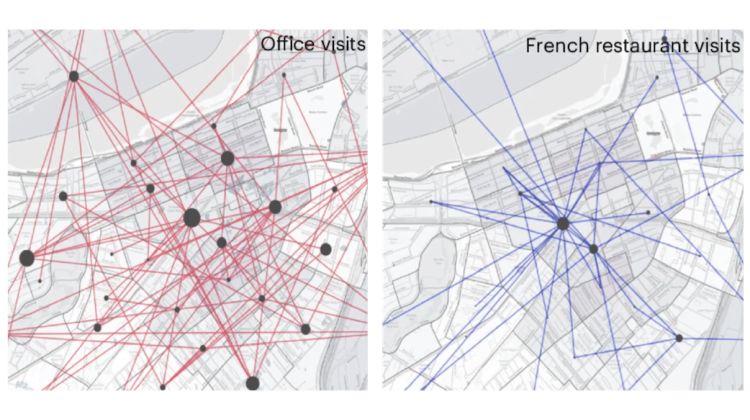Adding Detail to the Relationship Between Mobility and Economic Outcomes

Diverse activities in mobility networks, from "Infrequent activities predict economic outcomes in major American cities"
As one navigates a city, you might see an empty storefront or two with temporary marketing extolling the number of commuters who pass by the location on a daily basis - sometimes even broken down by mobility modality. These marketing efforts to entice businesses to rent a location are based on research linking volume of mobility and economic prosperity within cities. These studies tend to examine macroscale levels of activity, leading to fuzziness and controversy as to why mobility networks are effective predictors of economic outcomes. In a new paper for Nature Cities, a team of researchers focus on the behavior of individuals in the mobility networks to add clarity to the intersection between mobility and economic outcomes.
Utilizing data from mobile phones the team of researchers examined trips by activity frequency and points of interest to classify underlying behaviors for any given trip. Through their machine learning models, the team demonstrated that infrequent and irregular activities were better indicators of economic growth versus frequent and regular trips. “The activities with the strongest predictive power included French and New American restaurants, golf courses, hockey rinks, soccer games, and bagel shops. Such activities lead to more socioeconomic exploration, like building businesses, or developing social capital by connecting to more people,” says Shenhao Wang, DUSP alum and lead author of the paper. “These findings are an excellent reminder that we should be more exploratory in our own lives and welcome unexpected trips.”
Wang (PhD ‘20, MCP ‘17) is an assistant professor in artificial intelligence and the director of the Urban AI Laboratory at the University of Florida. His research investigates individual decisions across urban environmentals, spatiotemporal urban dynamics, and computational urban justice. Additional members of the team include MIT’s Yunhan Zheng (MCP '21, SM '21, PhD '24), Guang Wang (IDSS), Takahiro Yabe (IDSS), Esteban Moro (IDSS), and Alex ‘Sandy’ Pentland (IDSS).
“As you observe signs proclaiming the economic potential of a site based on the daily number of people who pass by, if you are considering renting the location for your new business, it is worth considering if those numbers are for folks who regularly pass the location or if there is a diversity of motivations and regular numbers of novel visitors to better assess the economic potential value of a location,” adds Wang.
Read the full paper, “Infrequent activities predict economic outcomes in major American cities”


